Cats exhibit a wide array of behaviors that both delight and puzzle their human companions. One particularly affectionate behavior is when a cat chooses to sit on a person’s chest. This action is often seen as a sign of trust and contentment but may also be influenced by their natural instinct to find the warmest and most secure place to rest. Understanding why cats engage in this behavior can deepen the bond between cats and their caregivers, highlighting the ways in which these animals communicate their needs and affections.
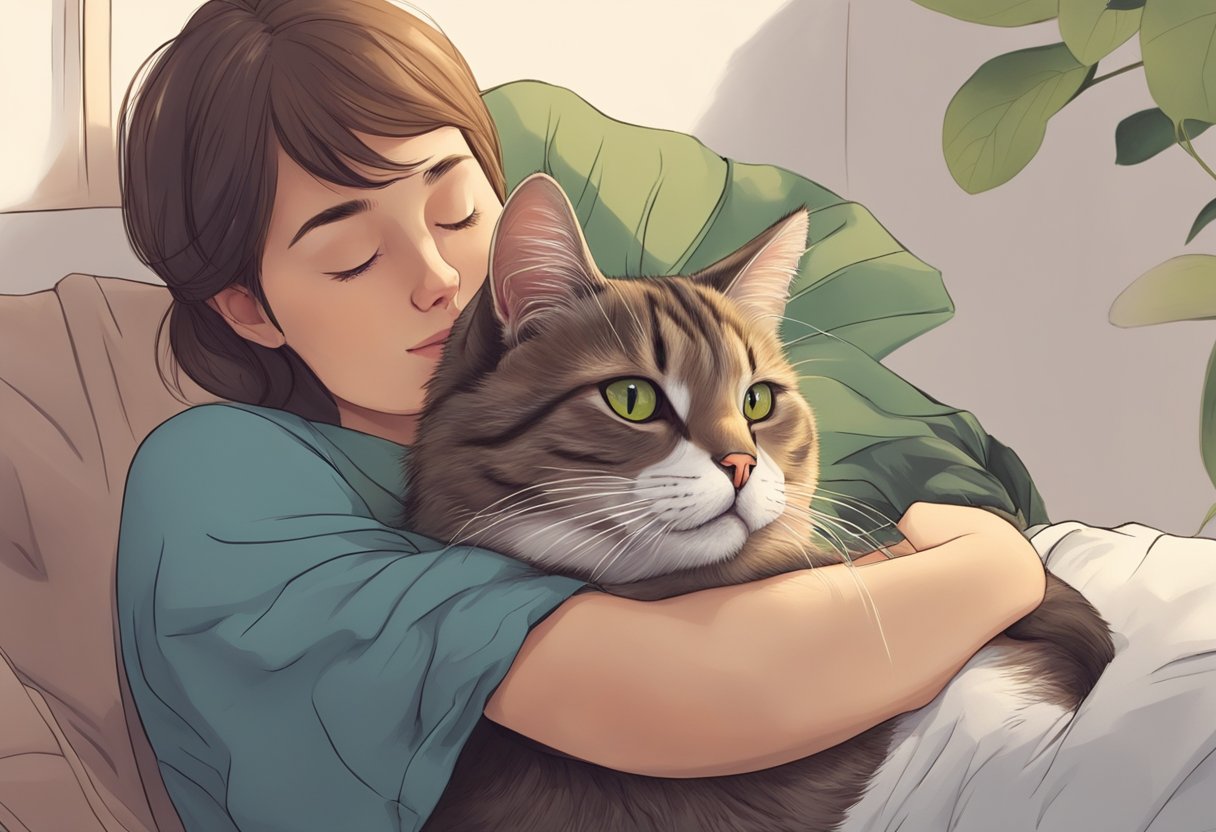
Sometimes referred to as “chest healing,” the act of a cat sitting on its owner’s chest may have emotional and physiological benefits for both the pet and human. The rhythmic purring and close proximity can be soothing and create a moment of relaxation and bonding. While not all cats will display this behavior, those that do are often seeking comfort or demonstrating a form of attachment to their human.
Key Takeaways
- Cats sitting on chests may indicate trust and affection.
- The behavior can provide warmth and comfort to the cat.
- It has potential emotional benefits for both the cat and the owner.
Understanding Cat Behavior and Chest-Sitting
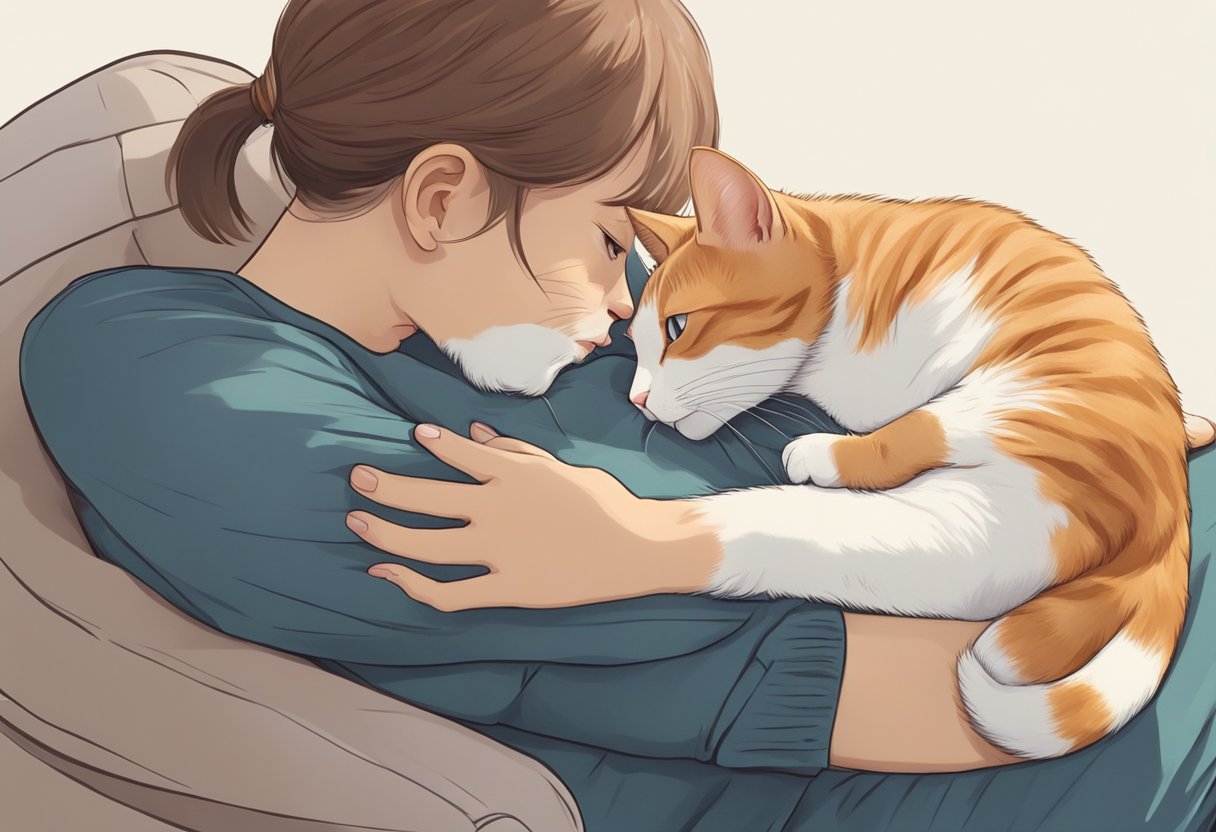
Cats exhibit a range of behaviors that may seem peculiar to humans, but chest-sitting is one that often signifies comfort and affection. Understanding why cats choose to sit on a human’s chest involves exploring aspects of cat behavior and body language.
Comfort: A human’s chest provides a warm and soft area for cats. They often seek out the coziest spots in the house, and a person’s body heat makes their chest an ideal choice.
Security: The act of sitting on someone can also be a sign of seeking security. Elevated positions give cats a better vantage point, allowing them to survey their surroundings.
Affection: Your stationary position while sitting or lying down offers a unique bonding opportunity. Chest-sitting may be a cat’s way of expressing trust and fondness, as it allows them to hear the soothing rhythm of a heartbeat.
Territory: Cats have scent glands on their cheeks and head. By rubbing against a person while chest-sitting, they are effectively marking their territory, indicating a sense of ownership and comfort with their human.
Cat Body Language: Observing a cat’s body language during chest-sitting can further clarify their feelings. A relaxed posture, slow blinking, and soft purring indicate contentment and affection.
Understanding these elements helps in appreciating this common feline behavior. While each cat is unique in how they express their emotions, chest-sitting is typically a positive signal in the complex world of cat behavior and body language.
The Comfort of Warmth and Security
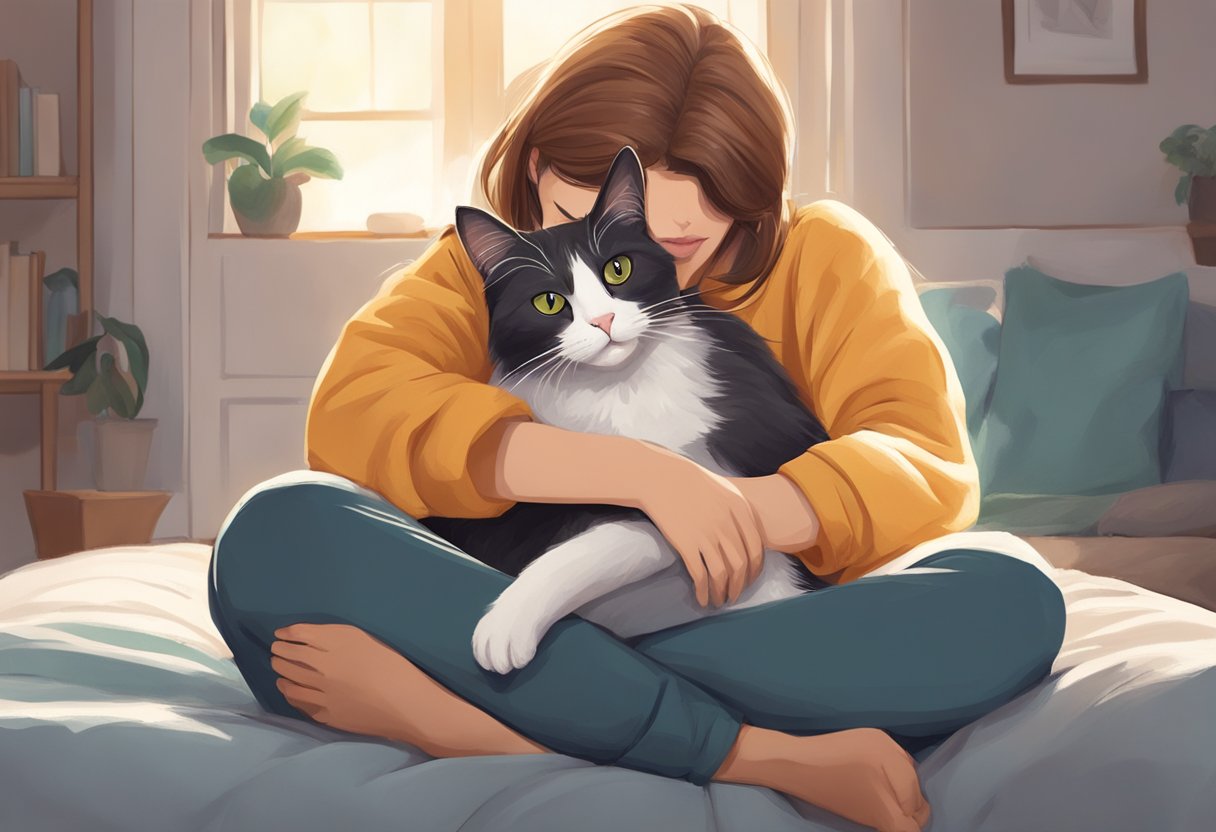
When cats choose to sit on a person’s chest, they are often seeking the warmth and the sense of security that this spot provides. This behavior is rooted in both their need for thermal comfort and their instinct for safety.
Seeking Heat and Coziness
Cats have a higher body temperature compared to humans, and they naturally seek warmth to maintain it. The chest offers not just body heat but also resembles the cozy environment they crave. Much like a heated bed, a person’s chest can be the ideal warm place, encouraging behaviors like kneading, which further increase the sensation of warmth.
Safety and the Soothing Heartbeat
In addition to the thermal aspect, the chest provides a sense of safety with the person’s steady heartbeat serving as a calming mechanism. This soothing rhythm can be reassuring, establishing the chest as a secure and tranquil retreat where they can let their guard down and relax. This is particularly comforting to cats that might be seeking protection or a hideaway from perceived threats in their environment.
Emotional and Physiological Benefits
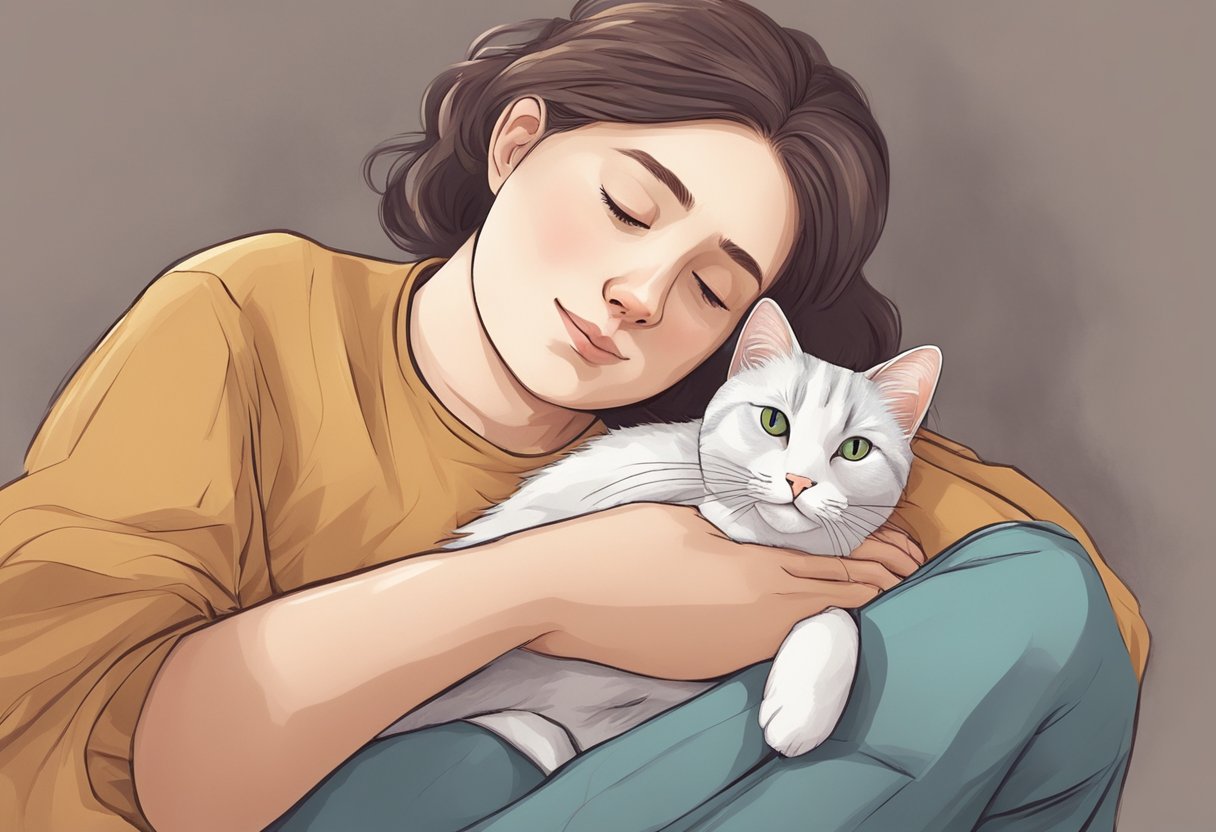
When cats sit on their owner’s chest, they offer emotional and physiological benefits that can enhance the wellbeing of both the pet and the owner. These benefits range from reducing stress to providing health advantages associated with their purring.
Stress Reduction and Bonding
The act of snuggling with a feline companion can significantly reduce stress and anxiety in humans. Cats often choose to sit on chests as a sign of trust and affection, strengthening the emotional bond between the pet and the owner. The presence of a cat can trigger the release of oxytocin, a hormone associated with love and emotional support. This closeness allows a peaceful exchange of comfort and affection, fostering a mutually beneficial relationship.
Health Benefits of Purring
Cats have a unique purring mechanism that is believed to have healing properties. Research suggests that the vibrations produced by purring can promote tissue regeneration and may even have a health benefit for humans. These vibrations occur within a frequency range thought to be medically therapeutic, covering anything from healing bones to reducing pain. The body heat and rhythmic sound of the purring can also aid in calming a distressed mind, adding to the stress reduction benefits of cuddling with a cat.
Cat-Human Relationship Dynamics
The dynamics of the cat-human relationship are complex, influenced by behaviors such as scent marking for territory and the mutual need for attention and affection. These factors are integral in understanding why cats are drawn to sit on their owner’s chest.
The Role of Scent and Territory Signaling
Cats have a strong impulse to claim their environment and their owners through scent. They are ingrained with a territorial instinct which is communicated by rubbing their face on objects, or people, to deposit pheromones. This form of communication is vital to a cat’s sense of security. An owner’s chest becomes part of the cat’s territory, a place where the feline feels at home. These actions build a sense of familiarity and establish the cat bed not as a separate entity but as an extension of their marked space.
Understanding the Need for Attention and Affection
Cats, despite representations of independence, require and often seek out opportunities for companionship and affection. When a cat chooses to sit on their owner‘s chest, it is a display of trust and a way to seek attention in a very personal space. It’s a sign of intimacy, where a cat perceives its owner‘s chest as a safe place for sleeping, reducing anxiety, and strengthening bonds. Simple actions, like gentle stroking, can enhance these feelings and meet the cat’s need for affection, highlighting the depth of their relationship dynamics.
Interpreting Cat Behavior during Sleep Cycles
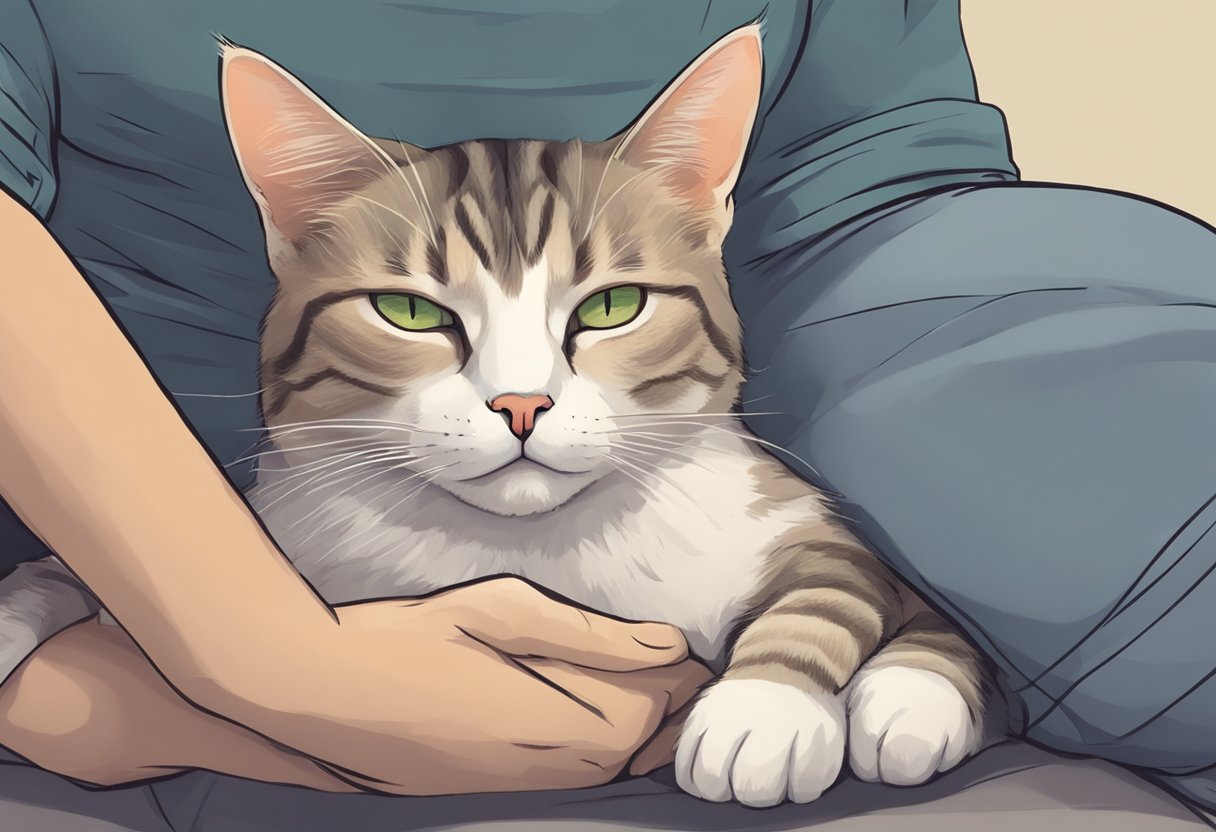
Cats exhibit particular behaviors during their owner’s sleep cycles that, while sometimes puzzling, are grounded in their instincts and bonding patterns. Understanding why cats choose to sleep on or near a person can shed light on the feline mindset and the trust they place in their human companions.
Why Cats Sleep on Your Chest
Cats often seek out the warmth and steady rhythm of their owner’s breathing as a source of comfort, leading them to nap on their owner’s chest. This behavior not only maximizes the physical closeness, enhancing the human-animal bond, but also provides a sense of security for the cat. A person’s chest represents a safe platform where they can relax and keep watch over their surroundings, particularly the bedroom door or other areas of potential disturbance. From this vantage point, they remain alert to any changes in their environment while feeling the reassuring presence of their trusted human.
Waking Up with a Cat on Your Chest
Waking up with a cat on your chest can be an indication of the cat’s trust and affection for their owner. A cat in this vulnerable state signifies they view their owner as a protector. Despite the relaxation of sleep, cats remain semi-alert during their rest periods, and their choice to position themselves on an owner’s chest may also stem from an instinctual need to wake up their owners quickly should any threats arise. Additionally, owners who wake up to find their cats on their chest are given a unique opportunity to strengthen the bond through gentle petting or a calm wake-up routine, reinforcing the cat’s behavior.
Comparative Behavior: Cats vs Other Pets
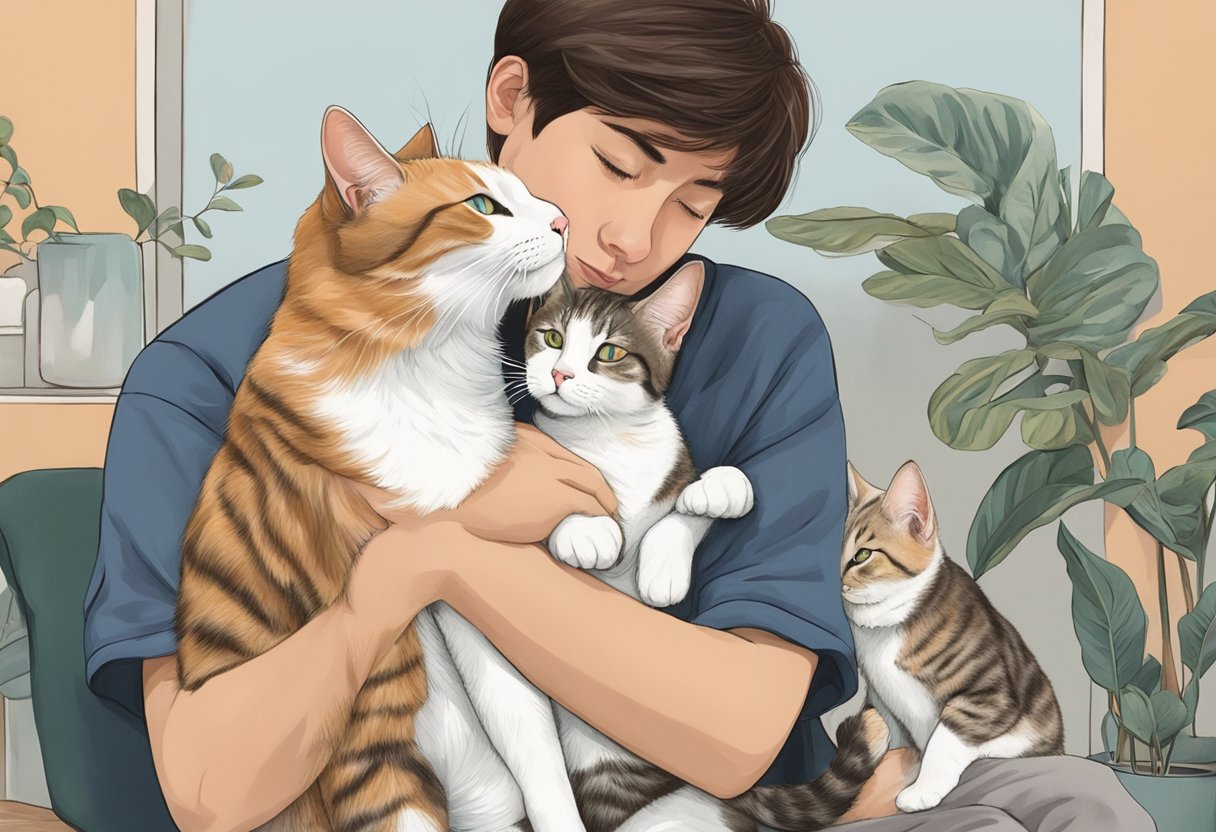
When examining the behaviors of cats compared to other pets, particularly dogs, it becomes evident that each species has its unique set of traits and needs influenced by their evolution and domestication. The inherent differences between feline and canine behaviors reflect their distinct roles as companions and their varied physical and emotional needs.
Cats versus Dogs
Cats often express their affection by sitting on their owner’s chest, which can be contrasted with dogs who may show affection through wagging tails, licking, or following their owners around. This behavior in cats is seen as them claiming their territory and seeking a warm, secure spot. Dogs, in comparison, are more likely to express their need for companionship through physical proximity without the need to be in an elevated position.
Cats’ chest-sitting habit also provides them with a vantage point, aligning with their instinctual preference for high places. Dogs, with their pack-oriented canine nature, may prefer to stay on the ground level, keeping a close eye on their surroundings and their pack members, which includes their human family.
Intrinsic Needs of Different Mammals
Understanding the intrinsic needs of different mammals informs their behavior. Cats have a well-developed sense of personal space and may require solitary time, which they balance with moments of seeking out physical closeness, such as chest-sitting, when they feel safe. Dogs, however, often display a more consistent need for social interaction and physical contact.
Differences extend to health needs as well, such as allergies, which can be more prevalent in people with dogs than those with cats. Companion requirements vary too; many dog breeds thrive with regular exercise and mental stimulation, while cats often prefer the safety and comfort of the indoor environment, punctuated with short bursts of high-energy play.
Both cats and dogs have adapted to human companionship over the years, developing behaviors that facilitate a symbiotic relationship with humans, yet they still reflect their individual evolutionary backgrounds.
Frequently Asked Questions

In this section, we explore common inquiries about feline behavior, particularly the reasons behind cats sitting on their owner’s chest and the implications of this behavior on emotional and spiritual levels.
What are the reasons cats prefer to sleep on their owner’s chest?
Cats often choose to sleep on their owner’s chest as it provides comfort and security due to the warmth and the soothing sound of a heartbeat. This behavior may also signify a strong emotional attachment similar to that found in other mammals.
Is there a connection between cats purring and the healing process while they lay on you?
Cats purring while laying on their owners is believed to have a healing effect, as the vibrations can be calming and are thought to promote bone and tissue regeneration.
How does a cat’s behavior change when their owner is experiencing sadness, specifically regarding their tendency to lay on the owner’s chest?
Cats can become more affectionate and may lay on their owner’s chest when they detect sadness or illness, possibly due to their ability to sense changes in human behavior or pheromones.
In the morning routine, why do cats have a habit of sitting on their owner’s chest?
In the morning, cats may sit on their owner’s chest as a way of seeking attention and indicating that it’s time to wake up, thus ensuring they receive their first meal or affection at the start of the day.
From a spiritual perspective, what significance might there be when a cat lays on your chest?
Spiritually, it is sometimes believed that cats laying on one’s chest can provide emotional healing and act as protectors by warding off negative energy.
Does the act of a cat stepping on your chest have an underlying behavioral explanation?
A cat stepping on your chest is often an exploratory or claiming behavior, indicating the cat’s comfort and ownership over their territory, which includes their human companion.
